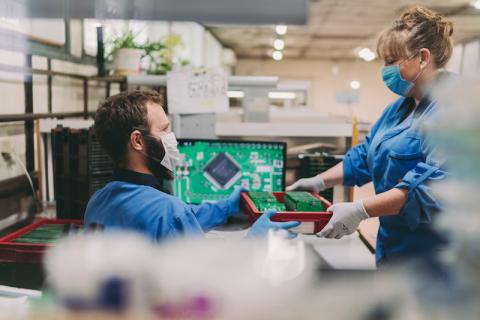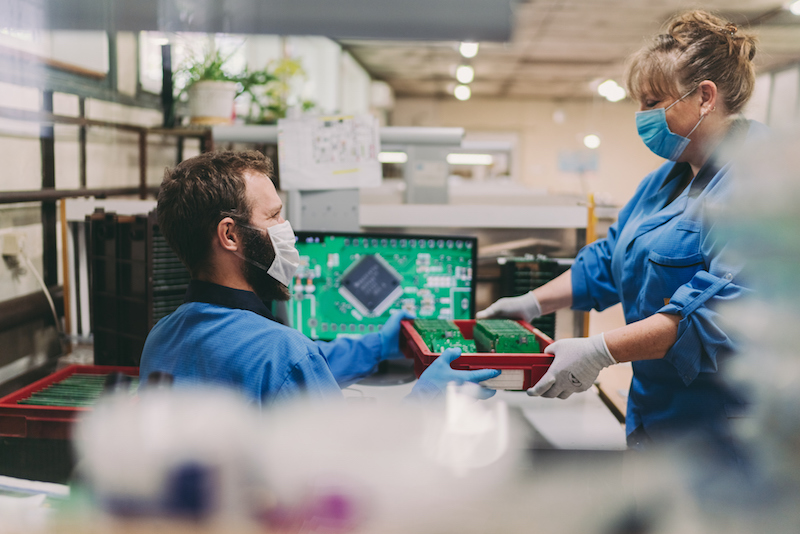Online Technical Training Blog

Automation in the Age of COVID-19
The COVID-19 pandemic has touched virtually every facet of daily life, from how we work and socialize, to how we purchase goods. In fact, many companies took the pandemic as a call to action, using automation technologies as a way to circumvent the challenges the pandemic caused. Specifically, when it comes to the manufacturing sector, the pandemic underlined the importance of adopting automated processes and even accelerated the implementation of automation into new areas previously reserved only for human workers.
Though the pandemic will first and foremost be remembered for the uncertainty that came along with it, it can also be argued that the pandemic has driven a shift in automation into new areas.
This article will examine the impact of the COVID-19 pandemic has had on new trends in industrial automation and how it has completely changed almost every industry.

Becoming More Intelligent and More Flexible
If we’ve learned anything from the COVID-19 pandemic, it’s that businesses that are able to adapt to unpredictable challenges quickly and remain flexible are more likely to not only survive, but thrive. The pandemic emphasized just how important this adaptability is, as we saw everything from retail stores to assembly lines completely shut down due to an unavailable human workforce. The need for many businesses to incorporate more automated processes into their operations, particularly those who’ve been slow to adopt new technologies, became increasingly important as the pandemic progressed and stay-at-home orders were lengthened. In short, leveraging automation technologies can help a company weather the next global event, particularly those that pose a risk to a company’s largest asset: its human workforce.
So, what does this mean, exactly? Well, one of the longstanding trends in manufacturing automation has been the gradual replacement of human workers with robots, cobots, AI, and other tools for processes that are deemed too dangerous or otherwise difficult or unpleasant for a human worker to perform. The idea is that human workers can be retrained and repositioned to roles that play to a human’s strengths while allowing the robotic workforce to produce a product at a rate that is faster, higher in accuracy, and consistent in amount. Having fewer human workers on the factory floor creates a tremendous amount of flexibility for a company that wants to meet demand for their products should another pandemic occur.
Will COVID-19 Be the Catalyst for the Fully Automated Workforce?
For some industries, it very well could be. Take Amazon for example. The multi-national company simply cannot hire and retain enough human workers required to handle the near complete shift from brick-and-mortar locations to online retail. Recent trends in automation have pointed to the eventual replacement of many human jobs and the COVID-19 pandemic has undeniably expedited that process for many businesses. Walmart and McDonalds, two of the world’s most prolific businesses in their respective industries, have already begun to use automated robots in an attempt to promote social distancing by reducing the number of staff that need to physically be at work. At some locations, Walmart already uses robots to keep their stores clean and, like Amazon, relies heavily on robots to efficiently sort, ship, and package products from their warehouses. McDonalds has begun testing robotic cooks and servers, meaning that fewer front-line workers will be needed to run the day-to-day operations at your local golden arches.
If we look at what’s happening in other countries around the world, we can see a more drastic example of how automation is impacting and enhancing certain workforces. Fleets of robots have been deployed in South Korea to dispense hand sanitizer and measure people’s temperatures in an attempt to reduce the spread of COVID-19.
New Trends in Industrial Automation
Of course, COVID-19 is in no way the only reason we’re seeing a shift toward automation; the use of automation technology is firmly entrenched in Industry 4.0. Having said that, it doesn’t mean that the pandemic hasn’t caused manufacturers to rededicate their focus when it comes to transformative technology. Here are some of the latest automation trends of 2022:
Increased Operational Resilience
There are many things that can jeopardize a company’s operational resilience as they transition from traditional operations to those consisting of automated technologies. This means manufacturers must ensure they’re prepared to address the kinds of risks to their business that’s more likely to occur as more technology is employed. This includes threats to cybersecurity, enhanced regulatory requirements, and stricter safety guidelines.
Expanded Remote Operations
COVID-19 has meant that companies could either shutter their operations or allow more and more employees to work in a variety of locations, including their homes. While many industries have long been hesitant to allow employees to work remotely, the use of cyber-secure tools has allowed many companies to transition their teams into a remotely connected workforce. This has allowed many companies to continue working seamlessly with their team members and clients.
However, not everyone can work from home. The manufacturing industry, for example, requires floor workers to appear in person in order for the day-to-day operations to run smoothly. In fact, only 46% of the industry has enabled remote work since April 2020. Floor managers, for example, are often able to work remotely as they can monitor the machines and make changes to operator data, no matter their location. Other factory floor jobs have been taken over by automated machines, which has impacted the lives of many factory floor workers. The silver lining, however, is that with new technology comes new opportunities. A person who lost their job due to COVID-19 can learn how to program and maintain the new technology that replaced them, upskilling instead of finding new work.
Innovation and Progress through Adversity
Adversity is perhaps far from the right word to describe the impact of the pandemic, but there is some truth to the notion that when faced with difficult situations or a change in societal values, humanity has been able to find ways to make things better.
Automation was always going to be the way of the future, but it’s clear that COVID-19 has expedited the adoption of automation technology for some manufacturers while shifting the focus for others. GBCTech Training has several Online Technical Training Certificate Programs to choose from if you’re interested in learning more about automation and its impact on our world. Find out more about our programs and kick-start your career today.


